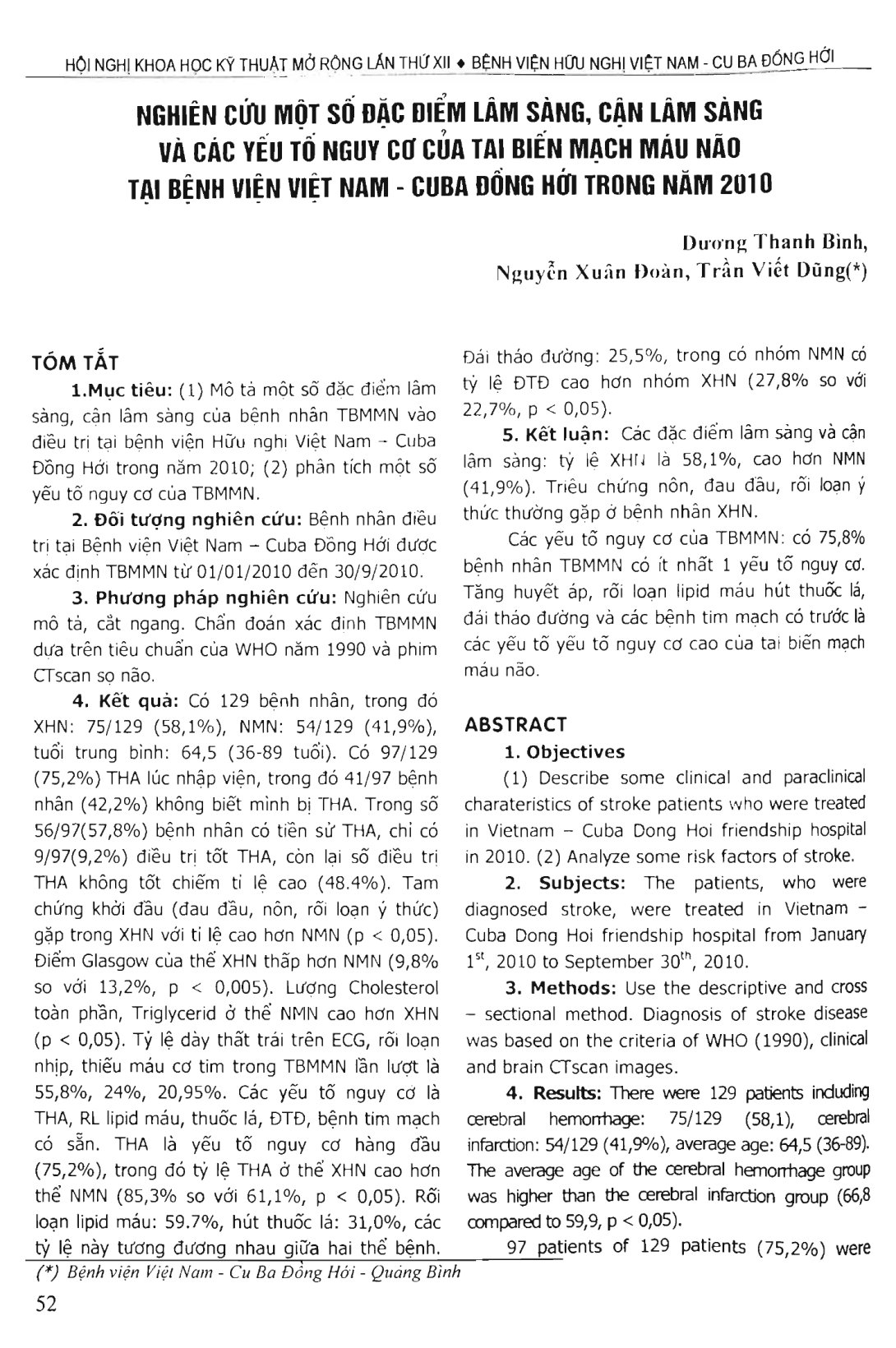
Research objectives: (1) Describe some clinical and paraclinical charateristics of stroke patients who were treated in Vietnam-Cuba Dong Hoi friendship hospital in 2010. (2) Analyze some risk factors of stroke. Subjects: The patients, who were diagnosed stroke, were treated in Vietnam Cuba Dong Hoi friendship hospital from January1st, 2010 to September 30th, 2010. Methods: Use the descriptive and cross - sectional method. Diagnosis of stroke disease n was based on the criteria of WHO (1990), clinical a and brain CTscan images. Results: There were 129 patients including cerebral hemorrhage: 75/129 (58.1 percent), cerebral infarction: 54/129 (41.9 percent), average age: 64.5 (36-89). The average age of the cerebral emorrhage group was higher than the cerebral infarction group (66.8 k compared to 59.9, P 0,05). 97 patients of 129 patients (75.2 percent) were hypertensive when hospitalized. 41 patients of 97 patients (42.2 percent) did not know they had hypertension. Among 56/97 (57.8 percent) patients with the history of hypertension, only 9/97 (9.2 percent) patients were treated well, the rest was not treated well, accounted for high rate (48.4 percent). Three initial symptoms in the cerebral hemorrhage (headache, vomiting, consciousness disorder) had the rate higher than in the cerebral infarction (p 0,05). Glasgow score of the cerebral hemorrhage was lower than the cerebral infarction (9.8 percent compared to 13.2 percent, p 0,005). The number of total Cholesterol, Triglycerid in the cerebral infarction was higher than in the cerebral hemorrhage (p 0.05). Left ventricle hypertrophy , arrhythmias, ischemic heart on ECG respectively were 55.8 percent, 24 percent, 20.95 percent. The risk factors were hypertension, dyslipidemia, diabetes, already cardiovascular disease. Hypertension was the leading risk factors (75.2 percent), in which the rate of hypertension in the cerebral hemorrhage was higher than in the cerebral infarction (85.3 percent compared to 61.1 percent, P 0,05). Dyslipidemia: 59.7 percent, smoking: 31.0 percent, these rates were equivelent between two diseases. Diabetes: 25.5 percent, in which the rate of diabetes in the cerebral infarction was higher than in the cerebral hemorrhage (27.8 percent compared to 22.7 percent, p 0,05). Conclusions: Some clinical and paraclinical charateristics: rate of the cerebral hemorrhage was 58.1 percent, higher than the erebral infarction (41.9 percent). Symptoms such as headache, vomiting, consciousness disorder usually appear in the cerebral hemorrhage group than in the cerebral infarction group. The risk factors of stroke : 75.8 percent stroke patients had at least one risk factor. Hypertension, dyslipidemia, smoking, diabetes, already cardiovascular disease were the high risk factors of stroke.
- Đăng nhập để gửi ý kiến
